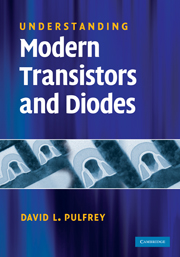Book contents
- Frontmatter
- Contents
- Preface
- 1 Introduction
- 2 Energy band basics
- 3 Electron and hole concentrations
- 4 Thermal equilibrium
- 5 Charge transport
- 6 np- and Np-junction basics
- 7 Solar cells
- 8 Light-emitting diodes
- 9 HBT basics
- 10 MOSFET basics
- 11 HJFET basics
- 12 Transistor capacitances
- 13 Transistors for high-speed logic
- 14 Transistors for high frequencies
- 15 Transistors for memories
- 16 Transistors for high power
- 17 Transistors for low noise
- 18 Transistors for the future
- Appendices
- Index
4 - Thermal equilibrium
Published online by Cambridge University Press: 05 June 2012
- Frontmatter
- Contents
- Preface
- 1 Introduction
- 2 Energy band basics
- 3 Electron and hole concentrations
- 4 Thermal equilibrium
- 5 Charge transport
- 6 np- and Np-junction basics
- 7 Solar cells
- 8 Light-emitting diodes
- 9 HBT basics
- 10 MOSFET basics
- 11 HJFET basics
- 12 Transistor capacitances
- 13 Transistors for high-speed logic
- 14 Transistors for high frequencies
- 15 Transistors for memories
- 16 Transistors for high power
- 17 Transistors for low noise
- 18 Transistors for the future
- Appendices
- Index
Summary
Thermal equilibrium in a semiconductor refers to the state when the temperature is uniform and has been steady for a long time, and when there are no sources of energy other than heat, e.g., no applied electric field nor optical irradiation. Obviously, semiconductor devices will not be in thermal equilibrium when they are in operation. However, it turns out that parts of a device often remain in a state very close to thermal equilibrium and, furthermore, knowledge of the carrier concentrations in thermal equilibrium is often a good starting point for understanding how a device works.
In this chapter, we briefly discuss the collision processes that tend to randomize the momenta of excited electrons and holes, then we introduce the thermal-equilibrium distribution function, develop some useful expressions for the carrier concentrations in equilibrium, and finish by considering the mean thermal velocity associated with an equilibrium distribution of electrons. The last property is a further step towards developing an understanding of current in diodes and transistors.
Collisions
In the previous chapter, we showed how the processes of recombination and generation alter the carrier concentrations in the conduction and valence bands. Under thermal-equilibrium conditions, the thermally activated band-to-band and chemical generation processes are operative, along with one or all of the following recombination mechanisms: radiative, RG centre, Auger.
- Type
- Chapter
- Information
- Understanding Modern Transistors and Diodes , pp. 49 - 62Publisher: Cambridge University PressPrint publication year: 2010



